Bans on single use plastics and on plastic drinking straws have been good for the environment but they have also raised questions in the gluten free community about whether paper straws have gluten and if hay is gluten free. What is in a paper straw or biodegradable plate, anyway? Is it paper or made from gluten? Can a wheat straw pass gluten into liquids? Can wheat based plates contaminate gluten free foods? How would we know?
Speculation around whether wheat straws, wheat bran-based plates, and other food contact materials might allow gluten to transfer into otherwise gluten free food, causing gluten cross-contamination, is a growing concern.
We don’t have to wonder any longer: new research proves that these fears for those on a gluten free diet are well-founded. Some wheat straws and biodegradable and compostable plates made from wheat do post a serious contamination danger to celiacs and others who must avoid gluten. Let’s examine which ones and how to avoid the risk.

Where Are Single Use Plastics Alternatives Being Replaced With Gluten?
Many food proteins are being used to create eco-friendly alternatives to single use plastics. Protein-based materials made from milk, egg, soy and wheat gluten – all top food allergens – are becoming more common, although vegetable, cellulose pulp and wood or bamboo are also prevalent.

In the case of wheat, the gluten found in wheat is particularly suited to making these materials, as gluten retains elastic properties when isolated from wheat flour.
In production, gluten is dried to a powder, then rehydrated for use in various shapes and forms like cups, plates, tableware and straws. Furthermore, gluten containing pasta-based straws (those made from cereals containing gluten, like semolina and durum wheat) are also cropping up in the marketplace.

Which Food Contact Materials Transfer Gluten to Food?
European Studies Find Gluten-Containing Tableware Transfers Gluten
An Italian study definitively showed that wheat bran-based plates caused gluten cross contamination above the allowable limit of 20ppm gluten when naturally gluten free food and prepared gluten free foods were served on them.
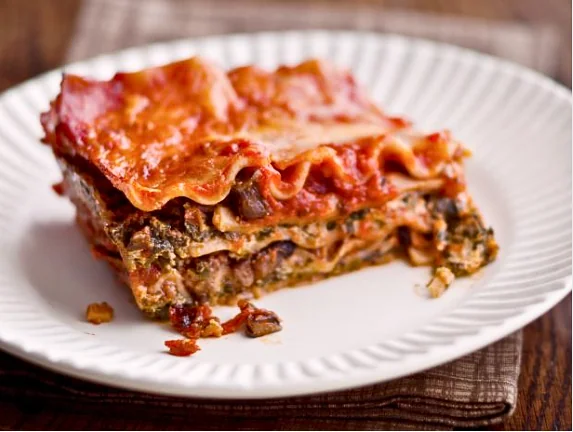
The study used two gluten free foods — room temperature soft cheese and hot gluten free lasagna — and placed them onto wheat bran-based plates for 30 minutes. Prior to the test, the gluten levels of both foods tested to below 5mg/kg gluten; after the 30 minute test, the gluten free cheese reached 45 mg/kg gluten and the gluten free lasagna exceeded 80mg/kg gluten. The daily limit of gluten considered safe for celiacs is only 10mg.
Based upon the results of this study, the Italian, Dutch and Spanish Coeliac Societies recommend that those with coeliac disease (celiac disease) avoid any food contact materials made from gluten-containing cereals or anywhere the content of the FCM is unclear.
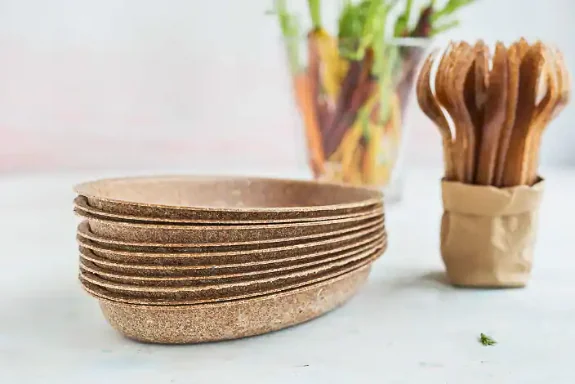
German Study Looks at Biodegradable Plates, Cutlery, Straws & Cups Made from Gluten
Another German study was recently published taking these tests further to assess the risk of exposure for those with wheat allergy and patients with celiac disease. The study tested different kinds of FCM, including biodegradable plates (100% wheat bran), forks and knives (wheat bran with polylactic acid), straws (1 made from durum wheat semolina and wheat gluten; 1 made from durum wheat semolina; 1 made completely of rye stalks), and a wafer cup (oat bran and wheat flour).
Gluten Transfer from Cutlery
The German study concluded that the potential gluten transfer from the wheat cutlery was negligible, likely because of small contact areas and short contact times. It was therefore deemed safe for people with celiac disease to use forks and knives made from gluten containing food.
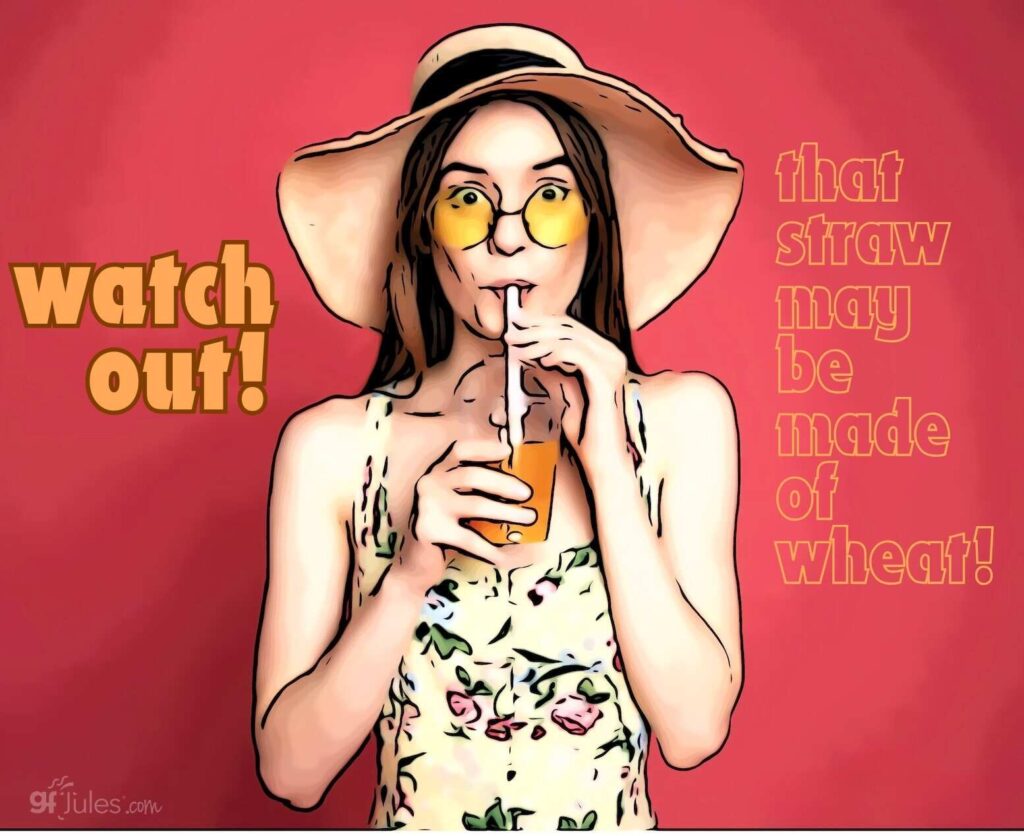
Gluten Transfer from Wheat Straws
However, the three wheat straws tested yielded concerning, and differing results. Based upon testing, the scientists concluded that straws made exclusively from wheat or rye stalks are safe for people with celiac disease because gluten is only present in the grains, not in other parts of the plants like the stalks. Straws that are simply a stalk or hay therefore do not pose a risk for gluten transfer.
The researchers also found no evidence of grain dust, however, they did recommend thoroughly cleaning these environmentally friendly straws in order to avoid any risk of potential gluten cross contamination.

In stark contrast to the straws made from wheat and rye stalks which contain no gluten, straws made from durum wheat and semolina are constructed largely of gluten itself. The testing showed that these gluten containing grains in the straws allowed gluten transfer at varying rates, depending on the liquids passing through them.
In order to avoid cross contamination, these kinds of wheat drinking straws should be avoided by people with celiac disease and others who must live gluten free.

Gluten Transfer from Plates
Plates made from wheat bran demonstrated a significant risk of gluten transfer of varying amounts depending on the food, liquid, contact time, and other variables, but also on the plate itself, pointing to a lack of consistency in the plate construction, even within the same lot.
The study concluded that “considerable amounts of gluten migrated from wheat bran-based plates into originally gluten-free liquids and foods. Therefore, wheat allergy and celiac disease patients definitely need to avoid using those materials.”
Gluten Transfer from Cups
The last biodegradable material tested was a wafer cup which the study authors filled with various liquids and tested for gluten using both the sandwich ELISA and the competitive ELISA methods. Based upon the amount of gluten migration found in all liquids, they advise patients following a strict gluten free diet against using these cups.
Conclusion: Gluten cross contamination occurred from the durum wheat semolina-based pasta straws, the wheat-bran based plates and the oat bran and wheat flour-based wafer cup. People with celiac disease, wheat allergy, or severe gluten sensitivity should avoid these products and the unnecessary anxiety that goes along with them, as they have been proven to cause a significant risk of cross contamination of gluten into otherwise gluten free foods.
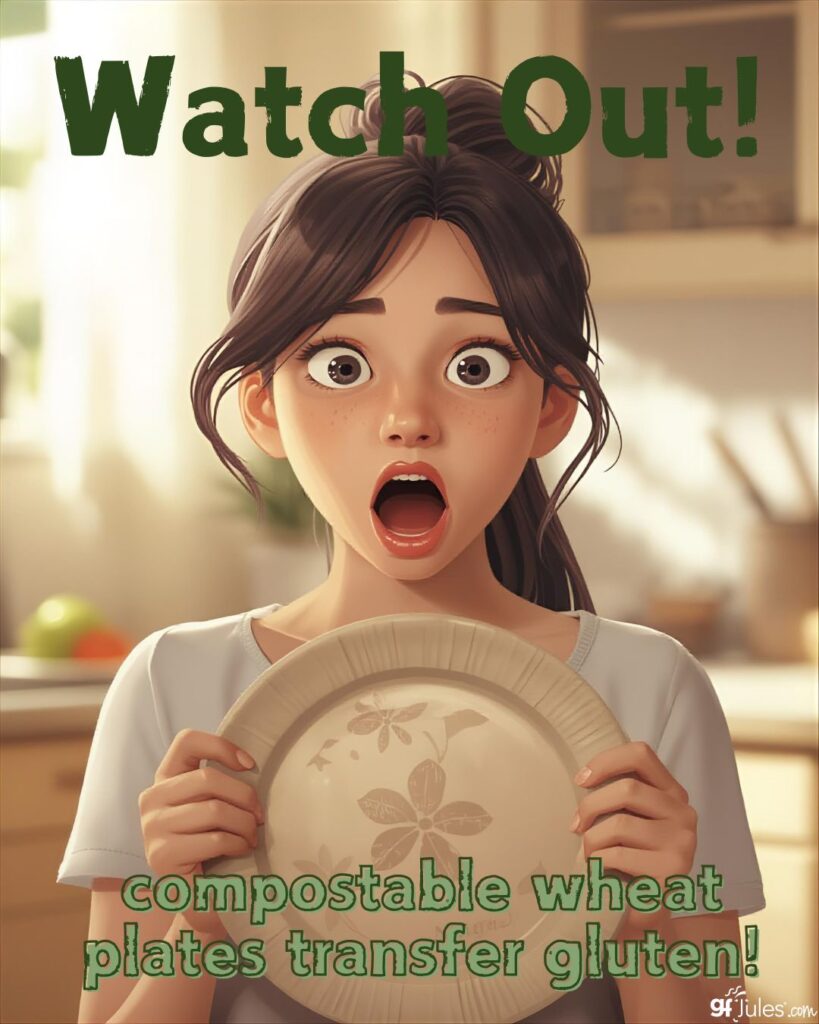
New Studies Examine the Risks from Wheat Ingredients in Plates, Cups, and Straws
A 2025 study out of Andalusia examined gluten transfer into various foods and liquids from wheat-based plates, cups, and straws. The study found several instances of gluten transfer into foods at levels above gluten-free thresholds. Because these non-food products don’t require allergen labels, the researchers say they could pose a health risk for those who need to avoid gluten.
The study found great variability in transferred gluten content amount biodegradable products, even when manufactured from seemingly similar raw materials. Study authors speculated that manufacturing, additive, and coating differences, as well as the use of different plant parts — some might include stalks, while others use bran; some might use leaves, while others use seeds — all could contribute to this variability in gluten exchange between different products.
It also found variability between the amount of gluten transferred based upon the type of food exposed to the wheat-based tableware. The study identified a pronounced susceptibility of liquids to gluten cross-contact (liquids = higher moisture content, lower viscosity, and greater surface spread), in comparison to solid foods like rice.
The Bottom Line:
Study authors first tested dishes, cups, and straws that were labeled as biodegradable or compostable and made with wheat or other gluten-containing materials. Only one plate had detectable gluten.
Gluten-free foods were then tested after being placed on the different tableware items at room temperature and after microwaving. (“Gluten-Free” threshold is below 20ppm)
- Rice: up to 17 ppm
- Omelet: up to 30 ppm
- Milk: up to 240 ppm
- Vegetable cream: up to 2,100 ppm
After microwaving on the dish, in some cases gluten contamination was actually reduced, leading researchers to hypothesize that heat denatures the gluten protein in such a way that it disrupts its transfer into the foods from these surfaces.
In notable conclusion, the authors stressed,
A Deeper Look at the Study:
The study authors also examined whether or not leaving the foods exposed to the wheat-based products for longer increased gluten transfer. Interestingly, they found that there was a non-linear trend toward contact time causing greater gluten transfer in solid foods, meaning that there was some increased gluten transfer the longer the food was exposed to the wheat plate, for example, but it didn’t necessarily get much worse when left for even longer.
Larger gluten transfers were seen because of a matrix of more complicated factors, not simply because of time. Physicochemical characteristics of foods, such as viscosity, factor into contamination risk assessments. There was a substantial increase in gluten transfer where vegetable cream was exposed to a cup made from wheat, by contrast, indicating that more viscous liquids may induce greater gluten transfer than other liquids like milk.
The final testing conducted by these study authors involved heating the contaminated tableware and exposing it to gluten-free food to determine if that increased, decreased, or did not affect any gluten transfer. The results were somewhat surprising, in that heating indeed changed the amount of gluten transfer, but it appeared to reduce it in most cases except for milk. Study authors hypothesized that this result was due to protein denaturation or altered binding capacities.
Must Food Allergens Like Gluten Be Labeled on Biodegradable Tableware & Straws to Alert Those on a Gluten Free Diet?
No. The answer is no. Not in the United States, not in Canada, not in the European Union.
There are currently no regulations that require the labeling of food allergens on food contact materials because they are not considered foods. However, now that we know that gluten and other food allergens may be transferred to otherwise safe gluten free foods from food contact materials, legislation is needed to require labeling for awareness and protection of food allergy and celiac consumers. The risks of contamination of naturally gluten free foods and prepared gluten free foods are the same, and the risks are significant to those living gluten free.
So, How Do I Stay Safe? What Compostable Plates Are Safe for Celiacs?
The best thing to look for if you’re gluten free is tableware made from materials like palm leaf, bamboo or other labeled compostable materials, not wheat. Contact the manufacturer directly if the product is not clearly labeled. Don’t take chances.
Until food-contact materials like biodegradable plates are required to disclose whether they contain wheat, gluten, or other allergens, you can’t rely on the packaging to be totally transparent about all the ingredients.
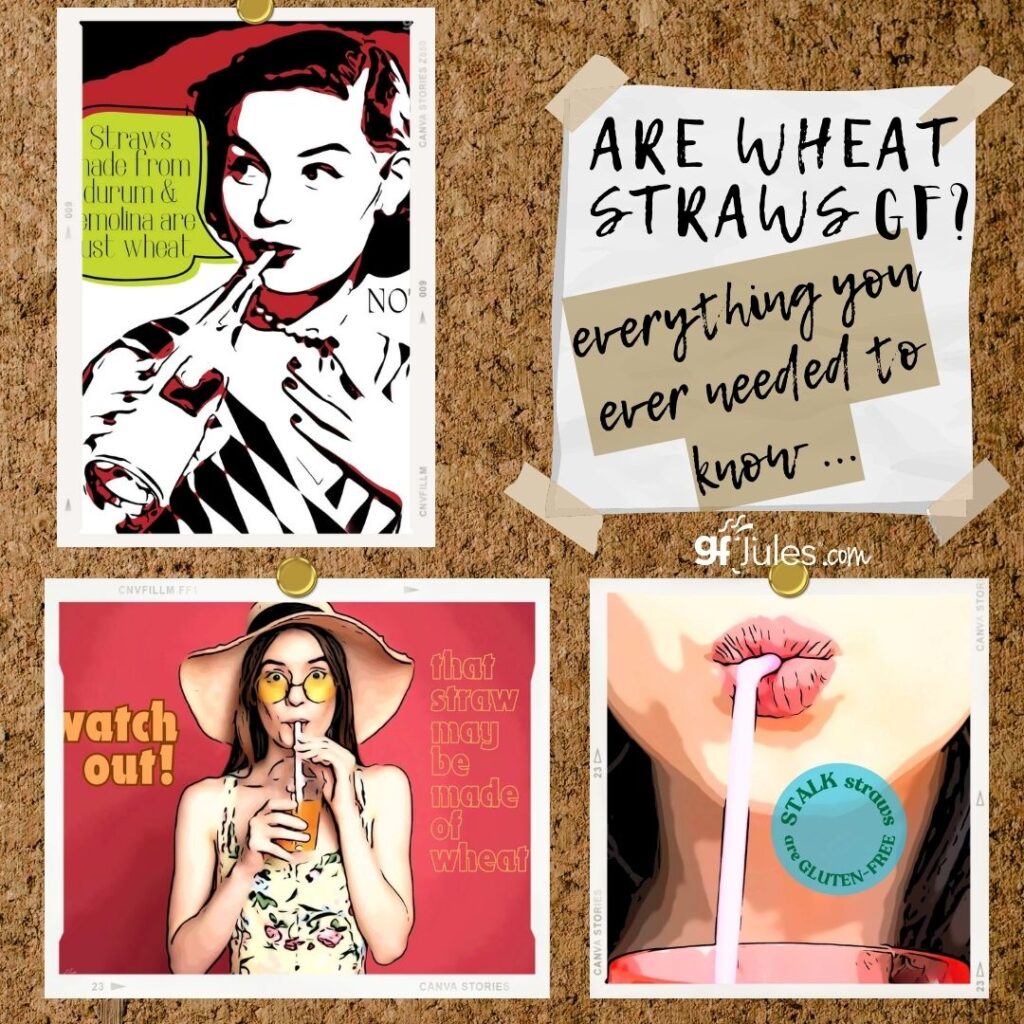




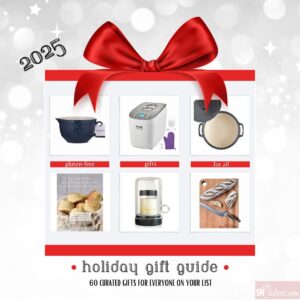



















I am looking to get new kitchen cutting boards to replace the badl cut up wooden and bamboo boards we have now. I see online some two-sided cutting boards with metal on one side and “Titanium Cutting Board for Kitchen, Cutting Board Double Sided Food Grade, Pure Titanium and Wheat Straw Polypropylene, Dishwasher Safe Easy to Clean Large Size” on the reverse side. Have you tested these yet for contaminants?
Hi JJ, I don’t personally test products like these for contaminants, no, but I would recommend avoiding anything with wheat if you need to avoid wheat or gluten due to health reasons.
~jules
Curious about Chipotle bowls now! Thoughts?
Hmmm good question. It’s likely that they are not made with wheat, as it’s less common in the States to find those wheat bran plates and bowls, and they are typically identified by a dark brown, flecked color (as pictured). Lighter colored bowls are usually not made from wheat. But the fact that these manufacturers don’t have to tell us anything about what their tableware is made from, is disturbing.
~jules